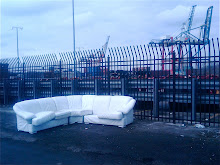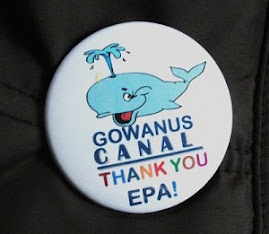
Today's New York Times has a story (
here) about the soon-to-open Cement Plant in Red Hook. This matter has been covered fairly well in the local press -
The Brooklyn Papers, The Brooklyn Courier and in blogs such as this one (my post
here). However, it's the first time a city-wide paper has done a story on this contentious development and it's great to see the matter get the visibility it deserves, especially in such an important publication as the NY Times.
In the article titled (using what would be a typically Brooklyn Paper-esque pun) "
Dust Has Yet To Settle Over New Concrete Plant", by Joseph Berger, it is noted that the placement of the plant next to "yellow-and-blue
Ikea next door, heavily used baseball fields across the street, and a 2.75-acre farm nearby on a former playground" is causing great concern. Noting that such developments may have come to Red Hook without objection years before, but that the timing of this development had created enough outrage from Red Hook's 11,000 residents to stage protests and garner 700 signatures on a letter of opposition to the plant, with signatures from such allies as representatives from the Red Hook Houses, the Red Hook Civic Association, Added Value Organic Farm and many others.
The article neglected to mention that the site was also located right next to the proposed
Brooklyn Greenway route - another seemingly incompatible neighbor to add to the long list.
The concern is that the dust from the plant would not only coat the organic greens produced at the
Added Value Organic Farm - produce that often ends up on the the menu of some of Brooklyn's finest eateries - not to mention into their workers' lungs, but that the dust would also compromise the air quality in the much used playing fields adjacent to the Cement Plant site. These fields are used, as the article notes, by "Brooklyn’s private schools as well as the borough’s mosaic of immigrants. The park is home to a rugby league, a Mexican baseball league and a Chabad Hasidic league."
Peter Morales, the commissioner of the Red Hook Little League, is quoted as saying that "during the season six of his teams play three days a week across from the plant."
“The kids running the bases breathe through their mouths, and they’re going to be inhaling this stuff,” he said.
One other interested party not specifically mentioned in this article - one that would seem to have problems with the location of this plant - is
Xavier High School. Xavier, as this
NY Post Article by Gary Buiso notes, has been approved to "refurbish the football field on Columbia Street (directly across the street from the Cement Plant), installing synthetic turf and bright lights making nighttime games or practices a new possibility. Xavier High School recently completed raising $1.5 million for a restoration of the field in Red Hook Park."
This deal was done before news of the new Cement Plant came to light ... I wonder what Xavier have to say about their new neighbor - especially after going through this long process, seeking Community Board 6 and Department of Parks and Recreation approval, carefully planning and painstakingly raising all that money.
It was interesting to see the spokesperson from
Ikea quoted in the piece as well. Early on it seemed as though Ikea would be making its objections to their new neighbors clearly known. But, as the article states, "Ikea, less than pleased, realized there was nothing it could do. Joseph Roth, Ikea’s director of public affairs, said that the company hoped that if the plant actually opened, it would be “a good neighbor.”"
I'm sure Ikea is still not pleased about the dust-creating hoppers from the plant being mere feet from their air conditioning intakes ... what challenges that poses for the efficient operation of those units, their maintenance and the effects on air quality within the store is another unknown in this whole equation.
A couple of phrases from this article resonated with me. Mr. Berger, the journalist, referred to Red Hook's "
split-personality", a nod to the
mixed-use character of Red Hook, with industry, commercial and residential all co-habitating. He also implies that, given Red Hook was not the "gritty, tumbledown" neighborhood in which previously (perhaps) a cement plant would have been seen as appropriate, it was the "timing" of the introduction of the plant that was the problem. The decision seemed archaic. Mr. Berger counts the introduction of the cement plant as running against "
counterintuitive changes" that have come to the neighborhood.
"
Counterintuitive"? That
also seemed to me like as good as description as any for some of the developments being introduced to our neighborhood - including the cement plant. I had thought of others - illogical, inappropriate, short-sighted, or just plain wrong. The
reality of Red Hook to those that live here can be vastly different than to those who merely gaze at zoning maps, or drive through on their way to IKEA or Fairway, or read articles referring to Red Hook as an "industrial neighborhood". Well it's not just an industrial neighborhood. Over 11,000 people live here - many in public housing. Families make their homes here and more are coming. Small businesses are opening by the week - many of them owned by residents. Our neighbors, from Red Hook and beyond, use the parks, bike routes and (albeit it limited) waterfront access and associated activities to enrich their lives. People are living their lives in this neighborhood, trying to make the most of it and trying to ensure that their health is not compromised by the activities of their neighbors. To ignore this fact is a slap to the face of those residents.
The article seems to acknowledge this fact. You don't need an outdated zoning map to let you know whether these developments are appropriate or not.
Wander around, have a chat to a local, drop into a store, get a feel for the place.
It's obvious.
View Proposed Cement Plant in a larger map
UPDATE: The Blog "Evironmental and Urban Economics - Thoughts on environmental and urban issues from an economics perspective." has an interesting post on this matter titled - "
Is Brooklyn a Green City - New Cement Production in Red Hook"In the post, Mathew E. Kahn asks -
"as Manhattan's boroughs become yuppie --- where should the nasty production activity take place? Where is the path of least resistance? Does this community "like" pollution? No, they are probably a renter; poor; low voice community who faces transaction costs to organize to oppose the entry of such a production facility. NIMBY politics causes this search . The issue is a property rights issue. Do communities have the right to not face such noxious facilities? Does the cement plant need to make a transfer to the community it enters and how large should that transfer be to compensate the "victims" for the quality of life damage its production causes."
Also he states -
"if the land where the Cement Plant is about to open has been zoned "nasty industrial" then property next to it should sell for a price discount to reflect the pollution damage that is likely to be caused by their neighbor."
He continues -
"if the land where the Cement Plant is about to open has been zoned "nasty industrial" then property next to it should sell for a price discount to reflect the pollution damage that is likely to be caused by their neighbor. If I can buy a cheap house because the house is next to a dump, I can't complain that I live next to a dump. I picked it and I was compensated for living there. So, my question here is "what is the new news?" Is the cement factory nastier than was expected? In this case, the neighbors have not been fully compensated for the damage they are now feeling. Alternatively, the neighbors want a free lunch of low land purchase price and no pollution."
The points he makes are valid ones - however, when you're talking about the prices of real estate reflecting the reality of noxious activities in a neighborhood - in other words - "you got a cheap house, so suck it up" - this kind of ignores the fact that most of the people who will have to bear the burden of the pollution in this case have no real choice of where to live. The residents of public housing are the vast majority of Red Hook's population. Asthma rates in Red Hook are around 40%. There is already enough pollution to challenge the health of the most vulnerable in our community - whether it be from the hundreds of trucks and private buses, container ships, cruise ships, car traffic on the BQE - with more truck and ship pollution coming from the relocation of Phoenix Beverages.
Any additional pollution is a concern.
Isn't it fair to ask that any new business shouldn't impose further burden on the health of the community in which it hopes to operate - regardless of Zoning?
ONE MORE THING: In my last post on this subject,
here, I quoted the statements made to the Brooklyn Paper's Zeke Faux (article
here) - statements from Jim Vogel, aide to State Senator Velmanette Montgomery. He spoke out in a way that other representatives, including Councilmember Sara Gonzalez haven't on this matter. I thought they were worth repeating again.
Senator Montgomery's aide said,
"his office would keep fighting the plant because the neighborhood has changed since the “heavy industry” zoning was put in place decades ago."
Mr. Vogel went on to say,
“I don’t think they appreciate the density of this area and how litigious New Yorkers can be ... If you’re opening a cement plant in an area with a 40-percent asthma rate, you’d better open your pocket book, because you’re going to be spending a lot of time in court.”
UPDATE 2: The Brooklyn Eagle has an editorial commenting on IKEA's impact on Red Hook - but also referring to the Cement plant, (
here). Dennis Holt writes,
And then someone throws a spanner into things. A cement company is building a cement factory across the street from IKEA. The company has the legal right to do so, and no one seems to be able to do anything about it.
Apparently, IKEA hasn’t tried to use its influence, but a cement plant shouldn’t be built near a major destination shopping center, a waterfront park, and close by sporting fields. It really doesn’t belong on this part of Red Hook’s consumer waterfront. (my emphasis)
Mr. Holt is right on this one. Though, regarding the main thrust of his editorial referring to Ikea "keeping their promises" to the community of which it now is a part. There is the matter of the free Water Taxi - even to non-customers.
Unfortunately, that was a promise not kept.








